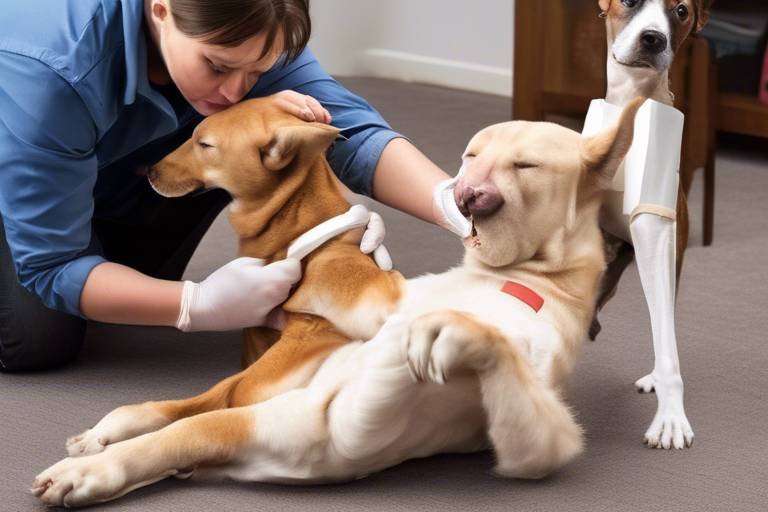What to Do If Your Pet Is Showing Signs of Distress
Pets are more than just animals; they are our companions, our family members, and often, our best friends. When they show signs of distress, it can be a heart-wrenching experience for any pet owner. Understanding your pet's behavior is crucial in providing them with the care they need. Distress can manifest in various forms, and being able to recognize these signs early can make all the difference in ensuring your furry friend remains happy and healthy.
So, what exactly should you look for? Changes in behavior, appetite, and even physical symptoms can all point to underlying issues that need immediate attention. For instance, if your normally playful pup suddenly becomes lethargic or if your cat, who usually greets you at the door, is hiding under the bed, these could be red flags. Being proactive is key, and knowing how to respond to these signs can help you provide timely and effective care for your beloved pet.
In this article, we will explore various signs of distress in pets, common causes, immediate actions to take, and long-term solutions to promote your pet's well-being. Remember, every pet is unique, and understanding their specific needs is essential to their health and happiness.
Recognizing signs of distress is the first step towards helping your pet. Pets can’t verbally express their feelings, so it's up to us to be observant. Here are some key indicators that your pet may be experiencing distress:
- Changes in Behavior: Sudden aggression, withdrawal, or unusual vocalizations can signal distress.
- Appetite Fluctuations: A sudden increase or decrease in food intake can indicate emotional or physical issues.
- Physical Symptoms: Look out for excessive grooming, vomiting, or changes in bathroom habits.
By keeping a close eye on these signs, you can act swiftly to address any potential issues before they escalate.
Understanding the causes of distress can help you better support your pet. There are various reasons why your pet might be feeling anxious or unwell. Some common culprits include:
- Environmental Changes: Moving to a new home, changes in family dynamics, or the introduction of new pets can cause anxiety.
- Health Issues: Illnesses or infections can lead to noticeable behavior changes.
- Emotional Trauma: Past experiences, such as abuse or abandonment, can leave lasting effects on your pet’s mental state.
Being aware of these factors can help you create a more stable and comforting environment for your furry friend.
Health-related issues are often at the root of distress in pets. Regular veterinary check-ups are essential for identifying potential problems before they become serious. Many health issues can manifest as behavioral changes, so it’s important to be vigilant. For example, pets suffering from infections or chronic illnesses may become withdrawn or irritable. Prompt veterinary intervention is crucial in these cases.
Infections and chronic illnesses can lead to significant behavioral changes in pets. For instance, a pet with a urinary tract infection may exhibit signs of distress such as frequent urination or discomfort. Recognizing these symptoms early can lead to timely treatment and a quicker recovery.
Chronic pain is another common issue that can severely affect a pet's quality of life. If your pet seems to be in pain, they might become less active or more irritable. As a pet owner, it’s crucial to recognize these signs and consult your veterinarian for advice on pain management options.
Changes in your pet's environment can also contribute to their distress. Whether it's moving to a new house, rearranging furniture, or introducing a new pet, these changes can create anxiety. Pets thrive on routine and familiarity, so sudden shifts can be disconcerting. Creating a stable environment can help alleviate some of this stress.
When you notice signs of distress in your pet, it's important to act quickly. Here are some immediate steps you can take to help calm your furry friend:
Creating a safe space for your pet is essential. This could be a quiet room with their favorite blanket or toys. You might also consider using calming products such as pheromone diffusers or anxiety wraps. Engaging in gentle play can also help distract them and ease their anxiety.
If your pet’s distress continues or worsens, it’s essential to consult a veterinarian. Signs that require immediate attention include:
- Persistent vomiting or diarrhea
- Severe lethargy
- Difficulty breathing
Being prepared for your vet visit by noting symptoms and any changes in behavior can help your veterinarian provide the best care possible.
To prevent future distress in pets, consider implementing some long-term strategies. Regular veterinary visits can help catch potential issues early. Additionally, behavioral training can significantly reduce anxiety and stress in pets, fostering a more harmonious environment.
Routine veterinary visits are crucial for maintaining your pet's health. These check-ups allow for early detection of potential health issues and ensure your pet stays up-to-date on vaccinations and preventative care.
Behavioral training can also help reduce anxiety in pets. This can include basic obedience training or more specialized techniques to address specific fears or phobias. A well-trained pet is often a happier pet, leading to a more enjoyable experience for both of you.
Q: What should I do if my pet is showing signs of distress?
A: Observe their behavior closely, create a calming environment, and consult a veterinarian if necessary.
Q: How can I tell if my pet is in pain?
A: Signs of pain can include whining, limping, or changes in eating habits. If you suspect pain, consult your vet.
Q: What calming products can I use for my pet?
A: Consider pheromone diffusers, anxiety wraps, or calming treats specifically designed for pets.

Recognizing Signs of Distress
As a pet owner, it’s crucial to be vigilant and observant of your furry friend’s behavior. Pets, much like humans, can experience a range of emotions, and sometimes those emotions manifest as signs of distress. Recognizing these signs early can make all the difference in ensuring your pet's well-being. So, what exactly should you be looking for? Well, let’s dive into the key indicators that your pet may be feeling uneasy.
First and foremost, any noticeable changes in behavior should raise a red flag. If your usually playful pup suddenly becomes withdrawn or your chatty cat goes silent, it’s time to pay attention. Pets often communicate their feelings through their actions, and a shift in their normal behavior can indicate something is off. Additionally, keep an eye on their appetite. A sudden loss of interest in food or treats could signal distress. On the flip side, excessive eating can also be a coping mechanism for anxiety.
Physical symptoms are another critical aspect to monitor. If your pet is experiencing distress, you may notice signs such as:
- Excessive barking or meowing: This could be a plea for help or a sign of anxiety.
- Shaking or trembling: Often a clear indicator of fear or discomfort.
- Hiding or seeking isolation: Pets may retreat to their favorite hiding spots when they’re feeling overwhelmed.
Moreover, keep an eye out for any unusual grooming habits. If your pet is excessively licking or scratching themselves, it could indicate stress or discomfort. These behaviors often serve as a way for pets to cope with their feelings. It’s essential to observe your pet over time to understand their unique behavior patterns, as every animal is different. What might be a sign of distress for one pet could be perfectly normal for another.
Furthermore, if you notice any physical changes such as weight loss, lethargy, or changes in the bathroom habits, these could be serious indicators that your pet requires immediate attention. It’s always better to err on the side of caution. If your instincts tell you something is wrong, trust them.
In conclusion, being attuned to your pet’s behavior can help you recognize signs of distress early on. By observing changes in their behavior, appetite, and physical symptoms, you can take proactive steps to ensure their well-being. Remember, your pet relies on you to be their voice, so stay alert and be their advocate!

Common Causes of Distress
Understanding the in pets is crucial for any loving pet owner. Just like humans, our furry friends can experience a range of emotions and reactions to their environment. Distress can stem from a variety of factors, and being aware of these can help you take proactive measures to ensure your pet's well-being. So, what are the typical reasons behind your pet's distress? Let’s dive into a few key areas that often contribute to their discomfort.
One of the most significant causes of distress is environmental changes. Pets are creatures of habit, and sudden alterations in their surroundings can lead to anxiety and confusion. For instance, moving to a new home, rearranging furniture, or introducing new family members (human or animal) can all trigger feelings of insecurity. Imagine being uprooted from your familiar space; it can be overwhelming, right? The same goes for our pets. They thrive on routine and familiarity, so any disruption can leave them feeling unsettled.
Another common culprit is health-related issues. Just like us, pets can suffer from various health problems that can manifest as distressing behavior. It’s essential to be vigilant about any changes in your pet’s behavior, as they can often be indicative of underlying health issues. Regular veterinary check-ups are vital in catching these problems early on. For example, chronic pain or infections can lead to noticeable behavioral changes, such as increased aggression, withdrawal, or even loss of appetite. If you notice your pet acting differently, it might be time to schedule a visit to the vet.
Additionally, emotional trauma can have a profound impact on your pet’s mental state. Events such as the loss of a companion, being abandoned, or even past abuse can leave lasting scars. Pets that have experienced trauma may exhibit signs of fear or anxiety, making it crucial for owners to create a safe and supportive environment. Just like a person who has gone through a tough time, these pets need time, patience, and understanding to heal.
In summary, recognizing the common causes of distress in pets can help you provide the support they need. Whether it’s environmental changes, health-related issues, or emotional trauma, being aware of these factors is the first step towards ensuring your pet’s happiness and well-being. Remember, a happy pet means a happy home!
- What are the signs that my pet is in distress? Look for changes in behavior, appetite, or energy levels. Signs can include excessive barking, hiding, aggression, or changes in eating habits.
- How can I help my pet during stressful times? Create a calm environment, provide comfort items, and engage in gentle play to soothe your pet.
- When should I consult a veterinarian? If your pet shows persistent signs of distress, or if you notice significant changes in their behavior or health, it’s best to seek professional help.
Health-Related Issues
When it comes to our beloved pets, can often be the silent culprits behind their distress. Just like humans, our furry friends can suffer from a range of ailments that may not be immediately visible. It’s crucial to be vigilant and recognize the signs early, as timely intervention can make all the difference in their recovery and overall happiness.
One of the most common manifestations of health problems in pets is a change in behavior. You might notice your usually playful pup becoming lethargic or your curious cat hiding away in a corner. These changes can be subtle, but they are significant indicators that something is amiss. For instance, if your pet suddenly loses interest in their favorite toys or refuses to engage in activities they once loved, it’s time to take a closer look.
Additionally, appetite changes can signal underlying health issues. A pet that suddenly stops eating or drinks excessively may be facing serious health problems, such as dental issues, gastrointestinal disorders, or even diabetes. It’s essential to monitor their eating habits and consult your veterinarian if you notice any drastic changes. Remember, pets can’t voice their discomfort, so we must be their advocates.
Another critical aspect to consider is the presence of chronic pain. Pets are incredibly adept at hiding their pain, often masking it until it becomes unbearable. Signs of chronic pain can include:
- Reluctance to move or play
- Changes in sleeping patterns
- Increased irritability or aggression
- Excessive grooming of a specific area
Recognizing these signs can help you act quickly. If you suspect your pet is in pain, it’s vital to seek veterinary advice. A veterinarian can provide a thorough examination and recommend appropriate treatments, which may include medications, physical therapy, or lifestyle changes.
Infections and chronic illnesses are other significant contributors to a pet's distress. Conditions such as urinary tract infections, skin infections, or even more severe diseases like cancer can lead to noticeable behavioral changes. It's essential to stay informed about your pet's health and maintain regular check-ups with your veterinarian. Early detection often leads to better outcomes.
In summary, being attentive to your pet's behavior and health is paramount. By recognizing the signs of distress related to health issues, you can take proactive measures to ensure your furry companion receives the care they need. Remember, a happy pet often reflects a healthy pet, so let’s work together to keep our beloved animals thriving!
Q: How can I tell if my pet is in pain?
A: Look for signs such as changes in behavior, reluctance to move, or excessive grooming of a specific area. If you notice any of these signs, consult your veterinarian.
Q: What should I do if my pet stops eating?
A: If your pet refuses to eat for more than 24 hours, it’s essential to contact your veterinarian, as this could indicate a serious health issue.
Q: How often should I take my pet to the vet?
A: Regular check-ups are recommended at least once a year, but more frequent visits may be necessary for older pets or those with existing health conditions.
Infections and Illnesses
When it comes to our beloved pets, their health is often a top priority. However, many pet owners may not realize how can significantly impact their furry friends' behavior. Pets, much like humans, can experience a range of health issues that manifest not only physically but also behaviorally. For instance, a normally playful dog may suddenly become lethargic or withdrawn, signaling that something is amiss.
Understanding the connection between health problems and behavioral changes is crucial. Infections such as kennel cough or urinary tract infections can lead to noticeable shifts in your pet's demeanor. You might notice that your cat is hiding more often or that your dog is reluctant to go for walks. These changes are often a cry for help, indicating that your pet is in discomfort or pain.
Some common symptoms to watch for include:
- Changes in appetite: A decrease or increase in food intake can signal an underlying health issue.
- Increased vocalization: If your pet is suddenly more vocal, it could be a sign of distress or discomfort.
- Altered bathroom habits: Straining to urinate or defecate can indicate a serious medical condition.
Moreover, chronic illnesses such as arthritis or diabetes can also lead to behavioral changes. Pets suffering from chronic pain may exhibit signs of irritability or aggression, which can be alarming for any pet owner. This is why it's essential to maintain a close observation of your pet's behavior and to be proactive about their health. Regular veterinary check-ups can help catch these issues early, allowing for timely treatment and better outcomes.
In summary, being vigilant about your pet's health and understanding how infections and illnesses can affect their behavior is vital. If you notice any of the signs mentioned above, it's crucial to consult your veterinarian as soon as possible. Remember, your pet relies on you to be their voice when they are feeling unwell.
Q: How can I tell if my pet has an infection?
A: Look for changes in behavior, appetite, or bathroom habits. Symptoms like excessive licking, unusual vocalizations, or lethargy can also indicate an infection.
Q: What should I do if I suspect my pet is ill?
A: Contact your veterinarian immediately for advice and potential examination. Early intervention is key to successful treatment.
Q: Are certain breeds more susceptible to specific infections?
A: Yes, some breeds are genetically predisposed to certain health issues. It's important to research your pet's breed and be aware of common health concerns.
Chronic Pain
Chronic pain in pets can be a silent but devastating issue that often goes unnoticed until it has significantly affected their quality of life. Imagine your furry friend, once full of energy and joy, now hesitating to jump onto the couch or play with their favorite toy. This change in behavior can be a clear indicator that something is wrong. Chronic pain can stem from various conditions, including arthritis, hip dysplasia, or even past injuries that didn't heal properly. It's crucial for pet owners to recognize these signs early on to provide the necessary care.
One of the most challenging aspects of chronic pain is that pets are experts at hiding their discomfort. They can't tell us when they hurt, so it's up to us to be observant. Look for subtle signs such as:
- Changes in activity levels
- Reluctance to move or play
- Excessive grooming of a specific area
- Changes in eating or sleeping habits
- Vocalizations like whimpering or growling when touched
If you notice any of these signs, it’s essential to take action. Chronic pain can lead not just to physical suffering but also to emotional distress. Pets in pain may become withdrawn or irritable, affecting their interactions with family members and other pets. Therefore, addressing chronic pain is not just about alleviating physical symptoms; it’s about restoring your pet's happiness and overall well-being.
Regular veterinary check-ups play a vital role in identifying and managing chronic pain. During these visits, your vet can assess your pet's condition and may recommend diagnostic tests such as X-rays or blood work to pinpoint the source of pain. Once diagnosed, there are various treatment options available, ranging from medications and physical therapy to dietary changes and weight management. Each of these approaches can help in reducing pain and improving your pet's quality of life.
In addition to professional treatment, there are several at-home strategies you can adopt to help your pet cope with chronic pain:
- Provide a comfortable and supportive bed to help ease joint pain.
- Maintain a healthy weight to minimize stress on the joints.
- Incorporate gentle exercises, like short walks, to keep them mobile without overexerting them.
- Consider supplements such as glucosamine or omega-3 fatty acids, which can support joint health.
Ultimately, being proactive about your pet's health can make a world of difference. If you suspect your pet is suffering from chronic pain, don’t wait for it to escalate. Consult with your veterinarian to explore the best options tailored to your furry friend's needs. Remember, a happy pet is a healthy pet!
Q: How can I tell if my pet is in pain?
A: Look for changes in behavior such as reluctance to move, excessive grooming, changes in eating habits, or unusual vocalizations. If you notice any of these signs, consult your veterinarian.
Q: What treatments are available for chronic pain in pets?
A: Treatment options may include medications, physical therapy, dietary changes, and weight management. Your vet will recommend the best approach based on your pet's specific condition.
Q: Can I manage my pet's chronic pain at home?
A: Yes, you can help manage your pet’s pain by providing a comfortable environment, maintaining a healthy weight, and incorporating light exercise. Always consult your vet before starting any new treatments.
Environmental Factors
When it comes to our beloved pets, their environment plays a crucial role in their overall well-being. Just like us, pets can feel stressed or anxious when their surroundings change. Imagine moving to a new city or bringing a new family member into your home; the same applies to our furry friends. They thrive on routine and familiarity, and any disruption can lead to signs of distress.
One of the most common environmental factors that can affect pets is a change in their living situation. For instance, if you’ve recently moved, your pet might feel disoriented in a new space that lacks their familiar scents and sounds. This can lead to behaviors such as hiding, excessive barking, or even inappropriate elimination. Similarly, introducing a new pet into the household can create competition for resources, leading to stress and anxiety in your existing pet.
Additionally, significant life changes—like the arrival of a baby, a new partner, or even the loss of a family member—can impact your pet's emotional state. They may not understand what is happening, leading to confusion and distress. It’s essential to monitor their behavior closely during these transitions and provide them with extra love and attention to help them adjust.
Moreover, environmental factors such as loud noises (think thunderstorms or fireworks) can trigger anxiety in pets. Dogs, in particular, are known for their acute hearing, which means they might react more dramatically to these disturbances than we expect. It's important to create a safe haven for them during such events, where they can retreat and feel secure.
Here are some key environmental changes to watch out for:
- Moving to a new home
- Introducing new pets or family members
- Changes in routine or schedule
- Exposure to loud noises or chaotic environments
To help mitigate these stressors, consider implementing some calming strategies. For instance, maintaining a consistent daily routine can provide a sense of security for your pet. Ensure they have a designated quiet space where they can retreat when feeling overwhelmed. You can also use calming products like pheromone diffusers or anxiety wraps to help soothe their nerves.
In summary, being aware of the environmental factors that can lead to distress in your pets is crucial. By recognizing these triggers and taking proactive steps to create a stable and comforting environment, you can help your furry friends navigate through life's changes with less anxiety and more confidence.
Q: How can I tell if my pet is stressed due to environmental changes?
A: Look for signs such as excessive barking, hiding, changes in appetite, or destructive behavior. If you notice these behaviors, it may indicate that your pet is feeling anxious or distressed.
Q: What can I do to help my pet adjust to a new environment?
A: Provide a safe space for your pet, maintain a consistent routine, and gradually introduce them to new areas of your home. Offering plenty of love and attention can also help them feel more secure.
Q: Are there any products that can help calm my pet?
A: Yes! There are various products available, such as pheromone diffusers, calming collars, and anxiety wraps that can help soothe your pet during stressful situations.

Immediate Steps to Take
When you notice your pet displaying signs of distress, it can be a heart-wrenching experience. The first thing to remember is to stay calm; your pet can sense your anxiety, which may only exacerbate their distress. Taking immediate action is crucial in alleviating your furry friend's discomfort. Here are some effective steps to consider:
First, create a safe space for your pet. This can be a cozy corner with their favorite blanket or a quiet room where they can retreat. Think of it as their personal sanctuary, where they can feel secure and relaxed. Make sure this space is free from loud noises and interruptions, allowing them to decompress in a familiar environment.
Next, consider using calming products available in the market. These can include pheromone diffusers, calming collars, or even natural supplements designed to soothe anxious pets. It’s like giving them a warm hug when they need it the most. Before using any product, however, consult your veterinarian to ensure it's safe and suitable for your pet's specific needs.
Engaging in gentle play is another excellent way to distract your pet from their distress. Playtime can help release pent-up energy and create a positive atmosphere. Try tossing a favorite toy or engaging in a light game of chase. Just remember to keep it low-key; the goal is to alleviate stress, not to overwhelm them further.
However, if your pet’s distress continues or worsens, it’s essential to consult a veterinarian. Look for signs that require immediate attention, such as excessive panting, vomiting, or lethargy. These could indicate underlying health issues that need professional intervention. When preparing for the vet visit, gather relevant information about your pet's behavior, diet, and any recent changes in their environment. This information can be invaluable for the veterinarian in diagnosing the problem effectively.
In summary, your immediate response to a distressed pet can make all the difference in their recovery. By creating a safe space, using calming products, engaging in gentle play, and knowing when to seek professional help, you can help your furry friend through tough times. Remember, they rely on you for support and comfort, so being proactive is key!
- What are the common signs of distress in pets? Look for changes in behavior, appetite, and physical symptoms such as excessive barking or hiding.
- How can I calm my distressed pet at home? Create a safe space, use calming products, and engage in gentle play.
- When should I take my pet to the veterinarian? If your pet shows signs of severe distress, such as vomiting, lethargy, or excessive panting, seek veterinary help immediately.
- Are there long-term solutions to prevent distress in pets? Yes, regular vet check-ups, behavioral training, and creating a stable environment can help reduce anxiety in pets.
Calm Your Pet
When your furry friend is showing signs of distress, the first thing you want to do is calm them down. Just like we feel overwhelmed in stressful situations, pets can experience anxiety and fear too. So, how can you help your pet find their zen? Here are some effective methods to create a soothing environment and help your pet relax.
First and foremost, consider creating a safe space for your pet. This can be a cozy corner in your home where they feel secure. Think of it as their little sanctuary, complete with their favorite blanket, toys, and maybe even a piece of your clothing for comfort. This familiar space can become a retreat for them during times of distress. You can also use calming products like pheromone diffusers or sprays that mimic natural calming scents. These can work wonders in alleviating anxiety and making your pet feel more at ease.
Engaging in gentle play can also be a fantastic way to distract your pet from their worries. Just like how a child might forget their troubles while playing with a toy, your pet can benefit from interactive play. Consider using toys that encourage them to engage physically and mentally. This not only diverts their attention but also helps release pent-up energy, which can be a source of anxiety.
Additionally, practicing calming techniques such as soft petting or gentle massage can significantly reduce your pet's stress levels. You might be surprised by how much a simple touch can convey reassurance and love. Focus on areas that typically relax them, like behind the ears or along their back. This physical connection can help strengthen your bond and provide them with a sense of security.
In some cases, you may want to explore natural supplements or calming treats designed specifically for anxious pets. However, it's crucial to consult your veterinarian before introducing any new products to ensure they are safe and appropriate for your pet's specific needs.
Remember, patience is key. Just as it takes time for us to unwind after a stressful day, your pet may need a little time to feel comfortable again. By being attentive and responsive to their needs, you can help your furry friend navigate through their distress and emerge feeling calm and secure.
- What are some signs that my pet is stressed? Look for changes in behavior such as excessive barking, hiding, or changes in appetite.
- How long does it take for a pet to calm down? It varies by pet, but providing a safe space and engaging in calming activities can help speed up the process.
- Are there specific products to help calm my pet? Yes, pheromone diffusers and calming treats can be effective, but consult your vet for recommendations.
- Should I change my pet's environment to reduce stress? If there are significant stressors like loud noises or new pets, creating a quieter space can help.
Consulting a Veterinarian
When your beloved pet shows signs of distress, knowing when to consult a veterinarian is crucial. It’s like being a detective; you need to piece together the clues your furry friend is giving you. If your pet is acting unusually, it might be more than just a passing phase. Paying attention to specific indicators can help you determine if a vet visit is necessary. For instance, if your pet is hiding, excessively vocalizing, or displaying signs of aggression, these could be red flags that something is wrong.
So, what should you look for? Here are some signs that warrant an immediate trip to the vet:
- Persistent Vomiting or Diarrhea: If your pet can’t keep food down or has diarrhea that lasts more than a day, it’s time to consult a professional.
- Loss of Appetite: A sudden change in eating habits can signal health issues. If your pet refuses to eat for more than 24 hours, don’t wait.
- Unusual Behavior: If your pet is lethargic, hiding, or seems unusually irritable, these changes in behavior can indicate distress.
- Physical Symptoms: Look out for signs like limping, swelling, or any visible injuries. If you see something, say something—especially when it comes to your pet's health!
Before heading to the vet, it’s helpful to prepare a few things. Think of it as packing for a trip; the more prepared you are, the smoother the process will be. Gather information about your pet’s symptoms, any changes in behavior, and their medical history. This information can be invaluable for the veterinarian in making a quick and accurate diagnosis.
During the visit, don’t hesitate to ask questions. It’s your pet’s health at stake, and you want to understand every aspect of their care. Questions like:
- What could be causing these symptoms?
- What tests will be needed to determine the issue?
- What treatment options are available?
After the consultation, follow any recommendations given by the veterinarian. This could include medication, dietary changes, or even behavioral training. Remember, your pet relies on you to be their advocate, so take an active role in their health care. Regular check-ups can help prevent many issues before they escalate, so make it a habit to schedule those vet visits.
Q: How can I tell if my pet is in pain?
A: Look for signs like whining, limping, or changes in appetite. If you notice anything unusual, consult your vet.
Q: What should I do if my pet is injured?
A: Keep your pet calm and contact your veterinarian immediately for guidance.
Q: How often should I take my pet to the vet?
A: Routine check-ups are typically recommended once a year, but younger pets or those with health issues may need more frequent visits.

Long-Term Solutions
When it comes to ensuring your pet's happiness and well-being, implementing is essential. Just like us, pets thrive in stable environments where they feel secure and loved. One of the most effective ways to achieve this is by making lifestyle changes that cater to their emotional and physical needs. Regular veterinary visits play a crucial role in monitoring your pet's health, helping to identify any potential issues before they escalate into serious problems. After all, prevention is always better than cure!
In addition to routine check-ups, consider integrating behavioral training into your pet's life. Training not only helps in correcting unwanted behaviors but also fosters a deeper bond between you and your furry friend. For instance, teaching your pet basic commands can provide them with a sense of structure and security. It’s like giving them a roadmap to navigate their world. Furthermore, positive reinforcement techniques can significantly reduce anxiety and stress, creating a more harmonious home environment.
Another vital aspect of long-term care is ensuring that your pet has a stimulating environment. Boredom can lead to distress, so providing toys, engaging in interactive play, and even setting up playdates with other pets can make a world of difference. Think of it as enriching their lives with fun and excitement, much like how we enjoy our hobbies and social interactions. Additionally, creating a safe space in your home where your pet can retreat when feeling overwhelmed is crucial. This space should be quiet, cozy, and filled with their favorite toys or blankets.
Lastly, consider the impact of your own lifestyle on your pet's well-being. Regular exercise, a balanced diet, and mental stimulation are key components of a happy pet. Just as we need our daily dose of physical activity and nutritious food, so do our pets. Make it a routine to take your dog for walks or engage in play sessions with your cat. This not only helps in maintaining their physical health but also strengthens your bond. In the end, a happy pet leads to a happy owner, creating a beautiful cycle of love and care.
- What should I do if my pet continues to show signs of distress? If your pet's distress persists despite implementing changes, consult your veterinarian for further evaluation.
- How often should I take my pet for veterinary check-ups? Regular check-ups are recommended at least once a year, but more frequent visits may be necessary for older pets or those with health issues.
- Can behavioral training really help my anxious pet? Yes! Behavioral training can provide structure and reduce anxiety, leading to a more relaxed pet.
- What are some signs that my pet is happy? A happy pet typically exhibits a relaxed body posture, playful behavior, and a healthy appetite.
Regular Vet Check-Ups
When it comes to keeping your pet healthy and happy, regular veterinary check-ups are absolutely essential. Think of your pet's health like a car; if you don’t take it for regular maintenance, it’s bound to break down at some point. Similarly, our furry friends can’t tell us when something’s wrong, which is why proactive vet visits are crucial. During these check-ups, veterinarians can catch potential health issues before they escalate into serious problems.
So, what exactly happens during a routine vet visit? Typically, the vet will conduct a thorough physical examination, checking your pet's weight, coat condition, and overall demeanor. They may also perform blood tests and urinalysis to check for underlying health issues that might not be immediately visible. It’s like getting a full-body check-up for your pet, ensuring that everything is running smoothly under the hood.
Moreover, these visits are an excellent opportunity for pet owners to discuss any behavioral changes or concerns they may have noticed. For instance, if your pet has been acting unusually anxious or withdrawn, bringing this up during a check-up can help the vet pinpoint possible causes, whether they be health-related or environmental. In fact, many health issues can manifest as behavioral changes, so being observant can make all the difference.
Another vital aspect of regular vet visits is vaccinations. Keeping your pet up-to-date on their vaccinations is essential for preventing serious illnesses. The vet will usually have a vaccination schedule tailored to your pet's age, breed, and lifestyle, which can be a game-changer in keeping them healthy. Additionally, some vaccinations are required for boarding or grooming facilities, so it’s a win-win situation!
To make the most out of your vet visits, here are a few tips:
- Keep a health diary: Jot down any changes in behavior, appetite, or energy levels. This information will be incredibly useful for the vet.
- Prepare questions: Don’t hesitate to ask about anything that concerns you. Your vet is there to help!
- Stay consistent: Try to schedule check-ups at least once a year, or more frequently for senior pets or those with ongoing health issues.
In conclusion, regular vet check-ups are a cornerstone of responsible pet ownership. They not only help in early detection of potential health issues but also provide a platform for open communication between you and your veterinarian. By prioritizing these visits, you're investing in your pet's long-term health and happiness, ensuring that they can enjoy their lives to the fullest.
Q: How often should I take my pet to the vet?
A: Generally, it's recommended to take your pet for a check-up at least once a year. However, senior pets or those with health issues may require more frequent visits.
Q: What should I expect during a vet visit?
A: Expect a thorough physical examination, discussions about your pet's health and behavior, and possible vaccinations or tests.
Q: How can I prepare for a vet visit?
A: Keeping a health diary, preparing questions, and ensuring your pet is calm can help make the visit smoother.
Behavioral Training
Behavioral training is a crucial aspect of ensuring your pet's emotional well-being and overall happiness. Just like humans, pets can experience anxiety and stress, and behavioral training can significantly help in alleviating these feelings. Imagine your pet as a sponge, soaking up everything around them – their environment, your emotions, and even the energy of other pets. If they’re exposed to negative stimuli or chaotic surroundings, they may react with distress. So, how can we turn that sponge into a confident, well-adjusted companion?
One effective way to initiate behavioral training is through positive reinforcement. This technique involves rewarding your pet for good behavior, which encourages them to repeat those actions. For instance, if your dog sits on command, rewarding them with a treat or affectionate praise can reinforce that behavior. Over time, this builds a strong bond of trust between you and your pet, making them feel secure and loved.
Another essential component is consistency. Just like a child needs structure, pets thrive on routine. Establishing a consistent training schedule helps your pet understand what to expect, reducing anxiety. For example, if you train your pet at the same time every day, they’ll begin to look forward to those sessions, associating them with positive experiences. Additionally, be mindful of your tone and body language, as pets are incredibly perceptive to these cues. If you approach training with patience and enthusiasm, your pet is likely to respond positively.
Incorporating socialization into your pet’s training regimen is also vital. Exposing your furry friend to various environments, people, and other pets can help them adapt to different situations. This exposure reduces fear and anxiety, making them more confident. However, it’s important to introduce new experiences gradually to avoid overwhelming them. Think of it as introducing a toddler to a new playground – you wouldn’t throw them into the deep end right away, right?
Moreover, consider enrolling your pet in a training class. These classes not only provide professional guidance but also create opportunities for socialization. Professional trainers have the expertise to identify specific behavioral issues and can offer tailored solutions. Plus, you’ll have the chance to meet other pet owners, sharing experiences and tips along the way!
Lastly, remember that behavioral training isn’t a one-time event; it’s an ongoing process. Regular practice and reinforcement of learned behaviors are essential for long-term success. Just like you wouldn’t expect to master a new skill overnight, your pet needs time and patience to learn and adapt. Celebrate the small victories and maintain a positive attitude throughout the journey.
- How long does it take to see results from behavioral training? The timeline can vary based on the pet's age, breed, and previous training experience. However, with consistent effort, you may start to see improvements within a few weeks.
- What if my pet doesn’t respond to training? Every pet is unique, and some may require different approaches. Consulting a professional trainer can provide insights and alternative methods tailored to your pet's needs.
- Can behavioral training help with anxiety? Absolutely! Behavioral training focuses on building confidence and reducing fear, which can significantly help pets dealing with anxiety.
Frequently Asked Questions
- What are the common signs of distress in pets?
Pets can show distress through various behaviors. Look out for changes in their eating habits, excessive barking or meowing, hiding, aggression, or unusual lethargy. If your pet seems more anxious or restless than usual, it's a good idea to investigate further.
- What can cause my pet to feel distressed?
There are multiple reasons why your furry friend might be feeling blue. Common culprits include environmental changes, such as moving to a new home or introducing a new pet. Health issues like infections or chronic pain can also lead to distress, so keep an eye out for any unusual behavior.
- When should I take my pet to the veterinarian?
If your pet shows signs of severe distress, such as difficulty breathing, persistent vomiting, or unresponsiveness, it's crucial to seek veterinary help immediately. Even if the signs seem mild, it's better to be safe and consult your vet if you're concerned.
- How can I calm my distressed pet at home?
Creating a safe and comfortable space for your pet can work wonders. Use calming products like pheromone diffusers or calming music, and engage in gentle play or cuddling to help soothe their nerves. Sometimes, just being there for them can make all the difference.
- What long-term strategies can I implement to prevent distress?
Regular veterinary check-ups are essential to catch any health issues early. Additionally, consider behavioral training to help your pet manage anxiety and stress. Establishing a routine can also provide your pet with a sense of security, promoting their overall well-being.



















